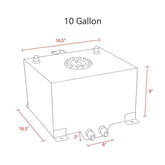What is Closed Crankcase Ventilation?
An internal combustion engine's closed crankcase ventilation system (CCVS) is a device that is mounted on the engine and intended to collect all particles, liquids, and gases released from the crankcase vent and direct them to the engine's intake air plenum for re-combustion.
How CCV Systems Work?
CCV systems are made up of several parts, such as filters, hoses, and valves, that work together to control crankcase emissions. These systems' main function is to carry blow-by gasses and oil vapor from the crankcase to the engine's intake manifold or air intake system.
The gases are subsequently pulled into the combustion chambers in this manner. They are afterwards incinerated through the normal combustion process, reducing their environmental impact.
What are the Types of Crankcase Ventilation Systems?
Depending on the installation and exhaust requirements, there are two types of ventilation systems depending on the installation and exhaust requirements: Open Crankcase Ventilation (OCV) and Closed Crankcase Ventilation (CCV).
When the crankcase blow-by exhausts to the atmosphere, OCV systems are used. An OCV system can be a straightforward wire mesh breather with low efficiency and little back pressure, or it might have a high efficiency coalescing element that is made to capture a lot of oil mist. The best OCV systems incorporate a crankcase pressure regulator, a vacuum source, and a high-efficiency coalescing filter. Utilizing open crankcase ventilation systems has the benefit of reducing the likelihood of contamination and oil build-up in the turbo and aftercoolers.
Whenever crankcase blow-by is directed back into the engine's intake, CCV Ventilation Systems are used. In most cases, it will be sent downstream of the engine air cleaner and downstream of the turbo (compressor wheel). Some of these will get into the exhaust of the engine. Closed crankcase ventilation (CCV) systems are being used increasingly often as a result of stricter environmental restrictions. Operators can monitor overall emissions through the engine's exhaust and stop an emissions source by venting blow-by back into the engine's intake stream. There are several installation types for closed crankcase ventilation systems, especially when the CCV has integrated pressure regulating technology (Solberg ACV).
Benefits of CCV Systems
- increasing engine performance. The truck will stop consuming oil vapors from the crankcase by shifting the filter away from the engine. This lessens accumulation in the air intake, improving performance and fuel efficiency.
- Reduce oil buildup in your turbocharger to lessen stress on it as well, which also lowers maintenance expenses. Many diesel owners claim that after installing a reroute kit to reposition their CCV filter, their engines run more smoothly and have increased power.
- CCV diversions move oil vapors out of the engine compartment instead of simply filtering them, putting less strain on your engine's oil filter system and requiring less frequent maintenance changes. This will save you money over time because you won't need to change the filter as often.
Application of CCV Systems in Specific Engines
CCV systems are used in many areas than just the car industry overall; they are applied to particular engines as well. To provide the best possible emissions control and performance, for example, the 6.7 Cummins and 6.7 Powerstroke engines frequently use CCV systems with certain filter designs and reroute configurations.
CCV filter replacements and reroute adjustments made specifically for these engines are beneficial. To increase the efficiency of the CCV system and prolong engine life, consider upgrading to specific CCV filters made for 6.7 Cummins and 6.7 Powerstroke engines.
Conclusion
In the automotive sector, closed crankcase ventilation (CCV) systems are essential for cutting emissions, boosting environmental sustainability, and improving air quality.
Crankcase gases are efficiently captured and recycled, which helps to maintain tight emissions requirements, enhance air quality, and lessen the overall environmental impact of internal combustion engines.
CCV systems continue to optimize emissions reduction and improve engine performance thanks to regular maintenance and continuous developments and advancements.









